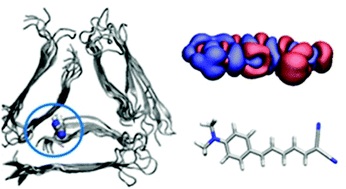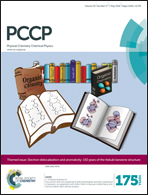Computational study on donor–acceptor optical markers for Alzheimer's disease: a game of charge transfer and electron delocalization†
Abstract
According to the amyloid cascade hypothesis, amyloid-β (Aβ) deposition is a central event in the Alzheimer's disease and thus, detection of Aβ deposits is crucial to monitor the progression of the pathology. Despite its low tissue penetration, fluorescence imaging may become an alternative technique for identifying these deposits because it is less toxic and less costly than positron emission tomography. Suitable dyes, however, should emit in the near infrared (NIR) region, cross the blood–brain barrier and target Aβ aggregates. In this work, we use TD-DFT, AIMD simulations and protein energy landscape exploration (PELE) to analyze the photophysical properties of a family of donor–acceptor markers and their binding to amyloid fibrils. These markers are formed by N,N-dimethylaniline donor and propanedinitrile acceptor groups separated by a spacer consisting of one, two or three conjugated double bonds. The smallest compound has a low emission wavelength, can deactivate through a non-radiative process involving a conical intersection and binds weakly to Aβ fibrils. In contrast, the largest dye is a suitable compound as it shows an emission wavelength in the NIR region, does not seem to relax through conical intersection processes and binds to Aβ fibrils strongly entering hydrophobic voids. Analysis of electronic excitations shows that the transition has an important charge transfer character that increases with the length of the spacer, the π bridge being an active participant in the transition. Therefore, adding double bonds to the dye skeleton has two beneficial effects: (i) it increases the emission wavelength as it enlarges the π system and (ii) it increases the charge transfer character of the transition, which increases the red-shifting of the emission wavelength in polar solvents.

- This article is part of the themed collection: Electron delocalization and aromaticity: 150 years of the Kekulé benzene structure

 Please wait while we load your content...
Please wait while we load your content...